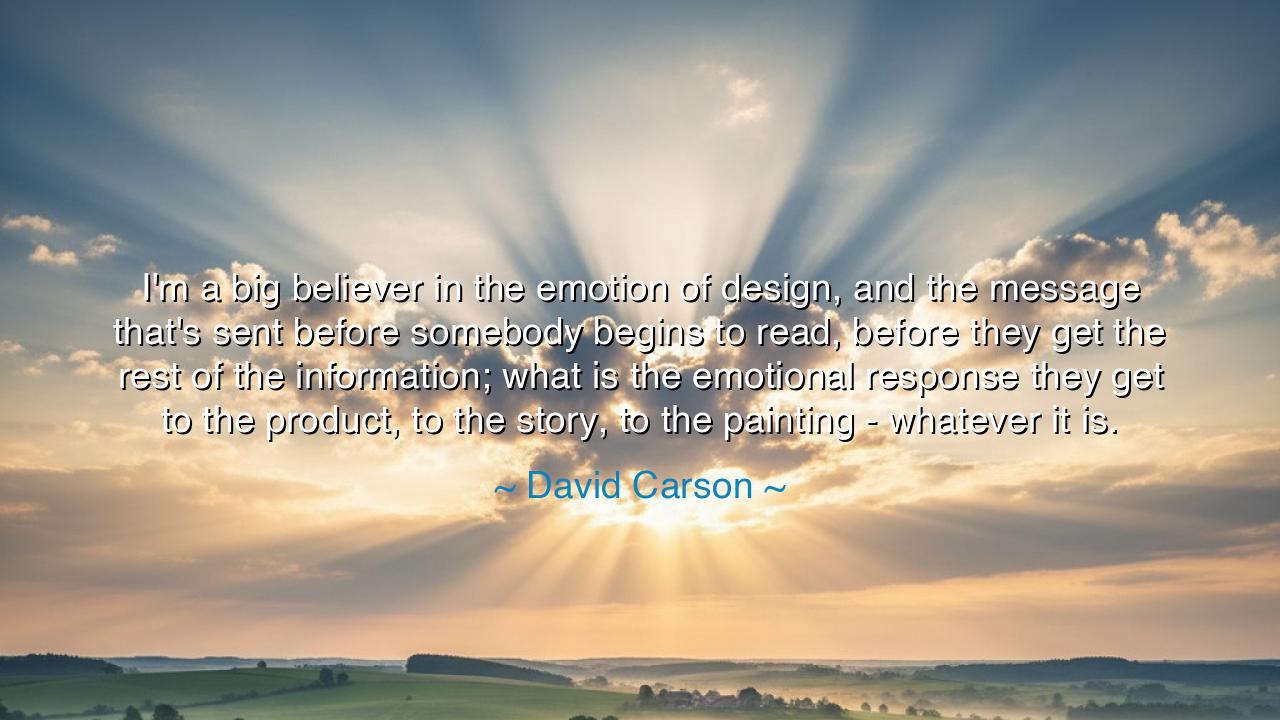
I'm a big believer in the emotion of design, and the message
I'm a big believer in the emotion of design, and the message that's sent before somebody begins to read, before they get the rest of the information; what is the emotional response they get to the product, to the story, to the painting - whatever it is.






In the words of David Carson, the pioneer of expressive typography and visual rebellion, we find a truth that transcends design and enters the realm of the soul: “I’m a big believer in the emotion of design, and the message that’s sent before somebody begins to read, before they get the rest of the information; what is the emotional response they get to the product, to the story, to the painting — whatever it is.” These words are not the musings of a mere designer, but the creed of an artist who understands that feeling precedes thought, and that the heart receives a message long before the mind interprets it.
The origin of this wisdom lies in Carson’s revolutionary work in the late 20th century, when he shattered the rules of traditional graphic design. While others sought clarity and conformity, he sought emotion — the raw, intuitive pulse beneath the surface of communication. In magazines like Ray Gun, Carson’s designs seemed chaotic to the untrained eye: text overlapped, letters danced, meaning seemed to dissolve. Yet, behind this apparent disorder lived a powerful truth — that design is not decoration, but communication of the soul. He believed that before words are read, before meaning is deciphered, the eye and the spirit already understand something. The emotion of design speaks directly to that ancient part of the human being which once read symbols in the stars, colors in the dawn, and patterns in the wind.
What Carson expresses here is a principle known to the masters of old. The builders of temples, the painters of icons, and the sculptors of gods all knew that form itself is language. The Parthenon, rising with perfect symmetry under the Athenian sky, spoke of balance and reason long before one heard the philosophers of Greece. The cathedrals of Europe, with their towering spires and stained glass, stirred awe and humility in the soul long before a priest uttered a word. The great artists of the Renaissance did not merely paint scenes; they orchestrated emotions. A gesture, a shadow, a curve — these carried meaning beyond speech. So too does Carson’s design philosophy remind us that visual experience is the first messenger of meaning.
When he speaks of the emotional response to a product, a story, or a painting, he teaches us that every act of creation must first touch the heart. A design that fails to move, fails to live. For in truth, emotion is the gateway to understanding. Before a viewer reads a word, their senses have already judged — they have felt attraction or aversion, comfort or tension, curiosity or indifference. This is the silent dialogue between creator and beholder, the sacred instant in which the unspoken becomes understood. Carson’s art, and his words, remind us that communication begins not with literacy, but with feeling — the primal intuition that binds all humanity.
Consider the story of Pablo Picasso, whose Guernica captures the agony of war not through literal representation, but through emotion distilled into form. The fractured faces, the screaming horse, the twisted light — before one knows the story of the bombing of Guernica, one feels its terror. That is the power of design that speaks before the mind begins to analyze. So it is with every act of deep creation — whether in visual art, architecture, or storytelling. When the heart is moved, the message has already arrived.
Carson’s insight reveals a profound truth about modern life: we have become so obsessed with information that we have forgotten emotion. We measure success in data and clarity, yet we fail to move the soul. But the ancients knew — and Carson reminds us — that the human being is not a machine. To communicate fully, one must speak not only to the mind but to the spirit. The first moment of encounter — the color, the shape, the sound — must ignite a feeling, or nothing else will follow. Whether one is designing a brand, writing a poem, or crafting a life, the emotional essence must come first.
Therefore, my listener, take this lesson as sacred: before you speak, before you write, before you build, ask yourself — what emotion will this awaken? Do not rush to explain; instead, seek to make others feel. Let your work carry a heartbeat. In every act of creation, remember that design — in its truest sense — is the bridge between form and feeling, between the physical and the spiritual. For as David Carson teaches, meaning does not begin with words; it begins with emotion, the first language of mankind.
And so, let your work — whatever its medium — carry that first spark of humanity. Let it speak before it is understood, let it stir before it informs. For the world does not hunger for more information; it hungers for connection, for the moment when a color, a sound, a gesture, or a design touches something wordless within us and whispers, “I understand you.” That is the eternal message of Carson’s wisdom — that all true art, all true design, begins where thought ends and feeling begins.






AAdministratorAdministrator
Welcome, honored guests. Please leave a comment, we will respond soon